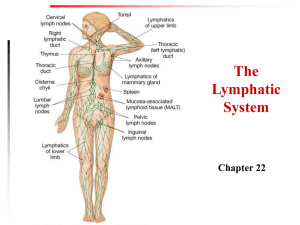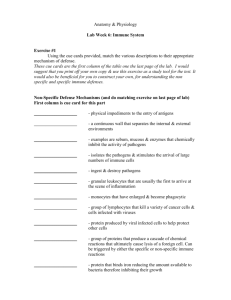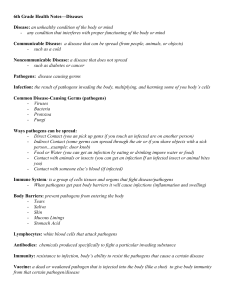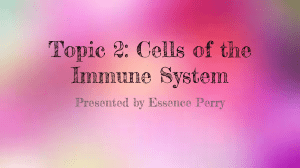Packet 19 Notes Aim:
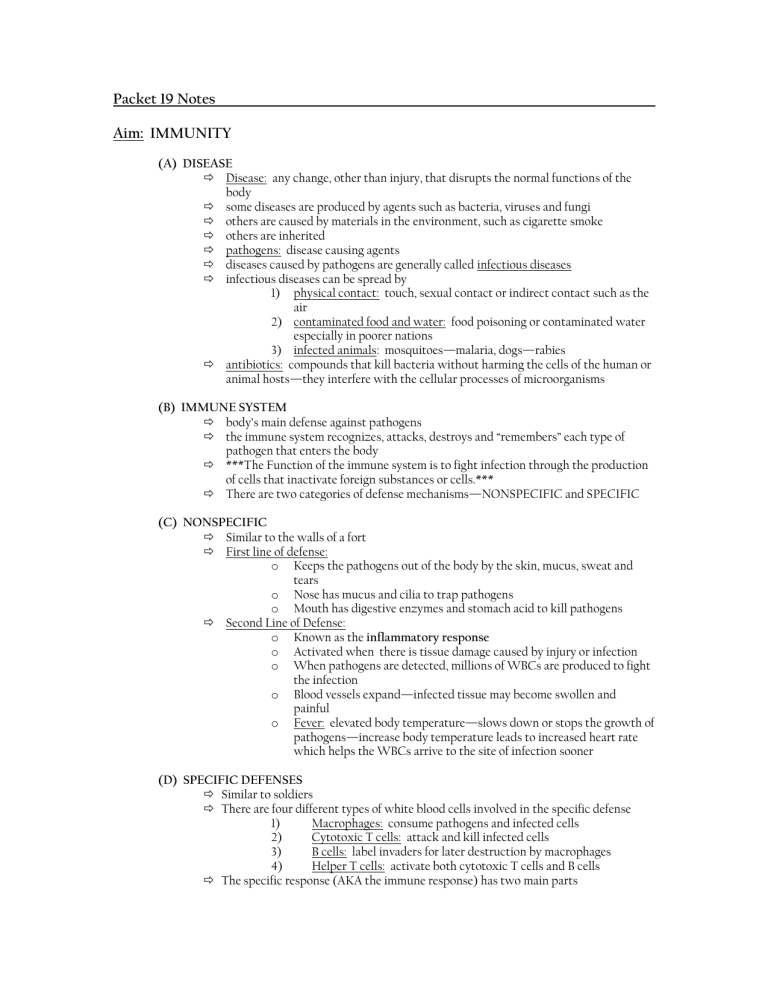
Packet 19 Notes
Aim: IMMUNITY
(A) DISEASE
Disease: any change, other than injury, that disrupts the normal functions of the body
some diseases are produced by agents such as bacteria, viruses and fungi
others are caused by materials in the environment, such as cigarette smoke
others are inherited
pathogens: disease causing agents
diseases caused by pathogens are generally called infectious diseases
infectious diseases can be spread by
1) physical contact: touch, sexual contact or indirect contact such as the air
2) contaminated food and water: food poisoning or contaminated water especially in poorer nations
3) infected animals: mosquitoes—malaria, dogs—rabies
antibiotics: compounds that kill bacteria without harming the cells of the human or animal hosts—they interfere with the cellular processes of microorganisms
(B) IMMUNE SYSTEM
body’s main defense against pathogens
the immune system recognizes, attacks, destroys and “remembers” each type of pathogen that enters the body
***The Function of the immune system is to fight infection through the production of cells that inactivate foreign substances or cells.***
There are two categories of defense mechanisms—NONSPECIFIC and SPECIFIC
(C) NONSPECIFIC
Similar to the walls of a fort
First line of defense: o Keeps the pathogens out of the body by the skin, mucus, sweat and tears o Nose has mucus and cilia to trap pathogens o Mouth has digestive enzymes and stomach acid to kill pathogens
Second Line of Defense: o Known as the inflammatory response o Activated when there is tissue damage caused by injury or infection o When pathogens are detected, millions of WBCs are produced to fight the infection o Blood vessels expand—infected tissue may become swollen and painful o Fever: elevated body temperature—slows down or stops the growth of pathogens—increase body temperature leads to increased heart rate which helps the WBCs arrive to the site of infection sooner
(D) SPECIFIC DEFENSES
Similar to soldiers
There are four different types of white blood cells involved in the specific defense
1)
2)
3)
4)
Macrophages: consume pathogens and infected cells
Cytotoxic T cells: attack and kill infected cells
B cells: label invaders for later destruction by macrophages
Helper T cells: activate both cytotoxic T cells and B cells
The specific response (AKA the immune response) has two main parts
B CELL RESPONSE
Aids the removal of extracellular pathogens from the body
Pathogens outside of the cell
T CELL RESPONSE
Involves the destruction of intracellular pathogens by cytotoxic T cells
Pathogens that are inside the cell
**Both are regulated by helper T cells**
The immune response proceeds in the following order:
1.
When a virus infects body cells, the infected cells display the viral antigen on their surface.
Antigen: a substance that triggers and immune response—generates the production of antibodies
Antibodies: defensive proteins produced upon exposure to a specific antigen, which can bind to that antigen.
2.
Macrophages engulf the virus and display the viral antigens on their surfaces.
3.
Receptor proteins on helper T cells bind to the viral antigen displayed by the macrophages.
4.
Helper T cells activate cytotoxic T cells and B cells.
5.
Activated B cells divide and develop into plasma cells. Plasma cells are cells that release Y shaped antibodies.
6.
Plasma cells make large numbers of antibodies and release them into the bloodstream where they attach to the virus and mark them for destruction
7.
The binding of antibodies cause viruses and antigens to stick together, forming clumps that can be easily identified and destroyed by macrophages.
8.
Activated cytotoxic T cells destroy infected cells by puncturing their cell membranes.

